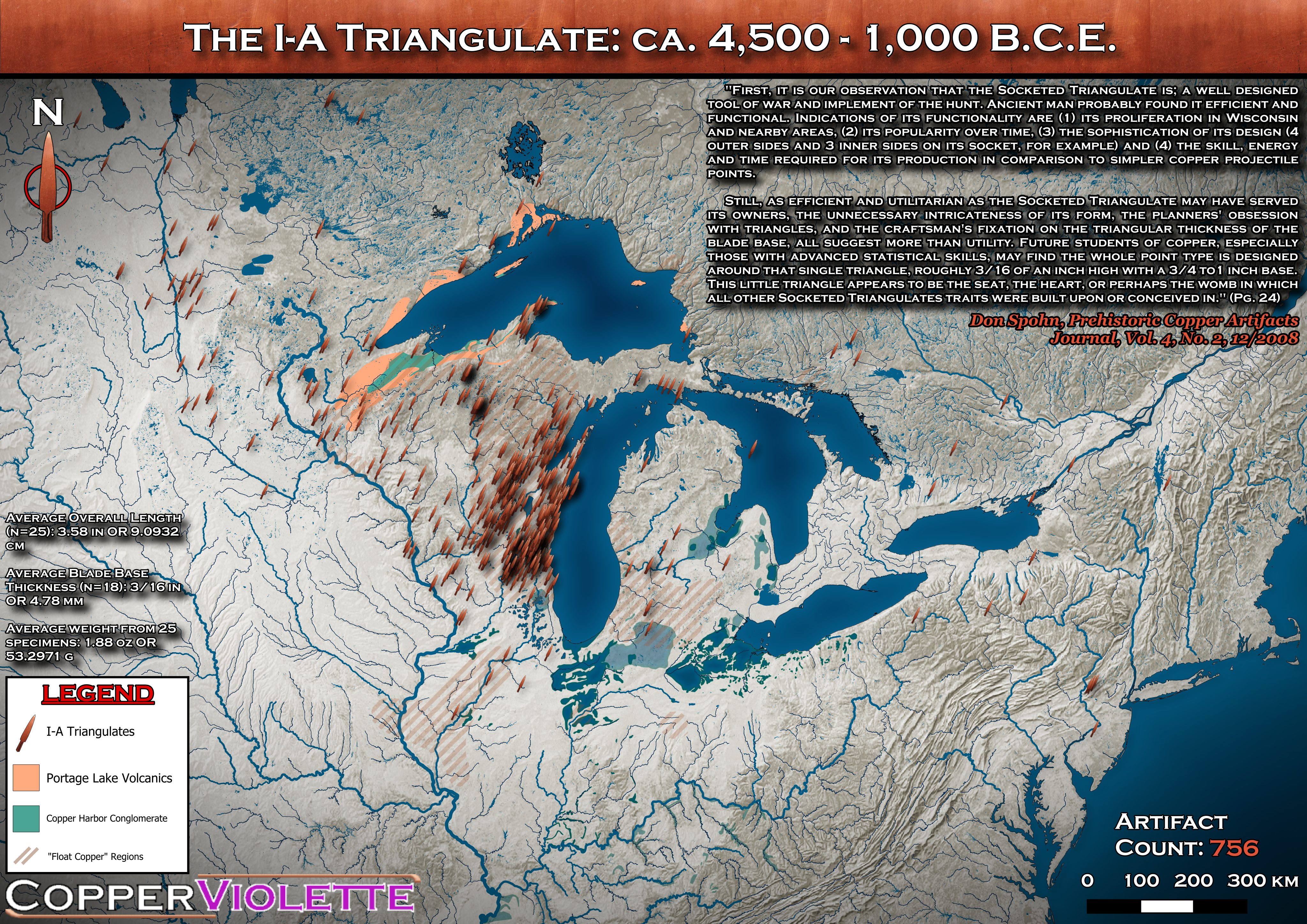I-A Triangulates Distribution Map of the Old Copper Culture


Marcus Rodriguez
Historical Geography Expert
Marcus Rodriguez specializes in historical cartography and geographic data analysis. With a background in both history and geography, he brings unique...
Geographic Analysis
What This Map Shows
This detailed visualization represents the distribution of I-A Triangulates, a prominent type of spearhead produced by the Old Copper Culture (OCC) between ca. 4500-1000 B.C.E. The map highlights regions where these artifacts have been found, with particular emphasis on clusters, notably in southern Wisconsin, where over 250 I-A Triangulates have been documented. With shadows enabled, areas exhibiting heavy shadowing indicate significant artifact concentrations, offering insight into the historical presence and activity of the OCC across the Great Lakes region.
Deep Dive into I-A Triangulates
The I-A Triangulate spearheads provide a fascinating glimpse into the technological advancements and cultural practices of the Old Copper Culture. These artifacts are significant not just for their physical attributes but also for what they reveal about the lifestyles and survival strategies of the people who created them. Made primarily from native copper sourced from the Great Lakes region, these spearheads were likely used for hunting and warfare, demonstrating a sophisticated understanding of metallurgy long before European contact.
Interestingly, the OCC is believed to have been one of the first cultures in North America to engage in the systematic extraction and use of copper, which was abundant in the region. The production of I-A Triangulates reflects not only the technological prowess of the OCC but also their social structures, as the creation of such tools would have required a certain level of organization and cooperation among community members.
Recent studies, including those by experts like Larry Furo and Monette Bebow-Reinhard, indicate that thousands of these artifacts remain undocumented, hidden within private collections or yet to be discovered. This ongoing exploration raises intriguing questions about the extent of the OCC's influence and the full scope of their material culture. The artifact count continues to grow, especially as new research and fieldwork are conducted, promising to enrich our understanding of this ancient society.
Regional Analysis
The map shows significant clusters of I-A Triangulates primarily located in the southern Wisconsin region, where archaeological efforts have revealed rich deposits of these artifacts. This area is particularly crucial for understanding the distribution of the OCC's technological innovations. For example, the high concentration in southern Wisconsin, with over 250 identified triangulates, suggests that this region may have served as a central hub for trade, resource allocation, or cultural exchange among neighboring communities.
In contrast, other areas within the Great Lakes region may show fewer artifacts, indicating varied patterns of occupation or resource availability. The presence of I-A Triangulates in northern Wisconsin and parts of Michigan further illustrates how these communities interacted with their environment. The geographical features, such as proximity to water sources and abundant natural resources, likely played a significant role in where these artifacts were found.
This distribution can also reflect the social dynamics of the OCC. Was southern Wisconsin a thriving center of innovation, or were the communities in northern regions equally as advanced but simply less studied? The ongoing documentation and analysis of these artifacts could provide answers to these questions, helping us to piece together a more complete picture of the OCC's societal structures.
Significance and Impact
Understanding the distribution of I-A Triangulates within the Old Copper Culture is essential for several reasons. Firstly, it sheds light on the technological advancements of ancient societies, demonstrating their ability to manipulate and utilize natural resources effectively. This knowledge can inform current discussions about sustainability and resource management, as we look to the past for insights into maintaining balance with our environment.
Moreover, the ongoing research and documentation of these artifacts highlight the importance of cultural heritage and preservation. With new editions of databases like the Copper Artifact Master Database being compiled, there's a growing recognition of the need to catalog and protect these historical artifacts. As more data becomes available, we can expect a more nuanced understanding of the OCC, enriching not only our knowledge of North American prehistory but also our appreciation for the complexities of human innovation.
In conclusion, the map of I-A Triangulates serves as a valuable tool for archaeologists, historians, and geography enthusiasts alike. It opens up avenues for further research and inquiry, connecting us to the rich tapestry of human history in the Great Lakes region. As we continue to uncover more about the Old Copper Culture, we may find that the lessons they left behind are more relevant to our contemporary world than we ever imagined.
Visualization Details
- Published
- September 20, 2025
- Views
- 66
Comments
Loading comments...